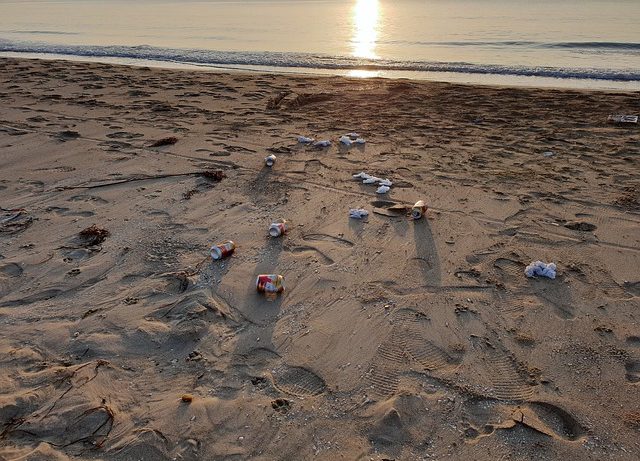Many of the coastal areas owned by the National Trust include beaches that are popular with visitors, particularly during the summer months and other holiday periods such as around Eastertime. Although the majority of visitors ensure that they leave no litter behind, a small but unfortunately significant proportion of people are not very aware of the environment, and leave waste such as sweet wrappers and drinks cans behind. However, a significant portion of litter pollution is also from waste that washes up on the shoreline, often from cargo that drops from the side of ships, but also from litter and other types of rubbish deposited into the sea from faraway locations, even from different continents! To counter against coastal litter-caused pollution, regular volunteer-led beach clean-up events are conducted by the National Trust, in order to keep shoreline environments free of litter and other forms of waste.
The Pollution Problem
The scale of litter pollution is rather high along the British coastline. Over the many years during which the clean-up events have been carried out, pollution from as far afield as Canada, Saudi Arabia and The Caribbean has been found washed up on the National Trust’s shores. Some of the items are decades old, including Lego pieces from a shipping container that was lost at sea in 1994, and have washed up on Britain’s shores ever since, and a bottle of rum from post-Prohibition America that was found on the beach at Formby in Merseyside. As interesting as these finds may be, they are rather harmful to wildlife – it has been estimated that over 100,000 marine animals die every year from either entanglement or the ingestion of items that wash up, or are discarded, in the sea or on the beaches. This is because litter and waste objects are harmful to animals in many ways, including:
- Bottles – these can trap fish, crabs and various other aquatic animals
- Lego pieces and other small pieces of plastic – these can be swallowed by many animals, in particular fish and dolphins
- Fishing netting – often deriving from commercial fishing vessels, this can entangle all animals, and is a specific problem for seals and seabirds
Although many tourists and visitors do ensure that the environment is kept as pristine as it was when they first arrived at coastal areas, some unfortunately leave their rubbish behind – not only is this still a considerable hazard to animals, but can also remain in the environment for a very long time. For example, volunteers recently found the remains of a picnic on Orford Ness in Suffolk, which contained food brands and packaging that was identified to be from the 1980s.
Beach Clean-Up Events
As an organisation with only limited money and resources, the National Trust runs regular beach clean-up events along the sections of coastline that it owns, in order to reduce the impact on animals, and subsequently the ecosystems within which they live, but also to keep the beaches looking clean for visitors, and to raise awareness amongst the public of the benefits of reducing litter. Although National Trust staff undertake some of the cleans, the work of many volunteers on each clean-up event is essential in reducing (or even mitigating) the level of litter on the coastline. The charity also encourages day visitors to help out too – at least by disposing of their own litter responsibly. Furthermore, the ‘Great British Spring Clean’ is a country-wide campaign that is organised by the charity Keep Britain Tidy to remove litter from all areas, including parks, woodland and beaches during March. The National Trust works with Keep Britain Tidy to encourage large beach cleans during this month, as well as promoting its own clean-up events that are carried out during the rest of the year. Working in partnership with Keep Britain Tidy (as well as other similar organisations through partnership agreements) has allowed the National Trust to remove litter and waste from its beaches more effectively.
Litter and Waste Reduction Initiatives
- Moreover, the National Trust has taken steps to ensure that its own premises, in particular shops and cafes, reduce the amount of litter generated. So far, the charity has taken steps to reduce and replace plastics that are both single use and damaging to the environment – these include:
- Using fully biodegradable packaging for food and drink products made from recycled and plant-based materials
- Replacing single-use plastic bags with paper ones
- Providing free drinking water in all of its stores and cafes
In addition to this, the charity announced in 2018 that it is to phase out the selling of all single-use plastics in all of its cafes and stores by 2022, including plastics bottles. As over 150 of its coastal properties – including shops and cafes – are adjacent to beaches, it is hoped that this initiative will help to reduce litter pollution within the National Trust’s coastline environments (as well as beyond National Trust property).
Since litter and waste pollution is a large problem within coastal environments, it is hoped that the clean-up events, as well as the charity’s own initiatives aimed at reducing single-use plastics, and encouraging biodegradable container usage, will all contribute to curtailing the amount of litter deposited on its beaches. Although the clean-up events are rather popular and successful, pollution still remains an issue, with the presence of both litter and waste still, unfortunately, continuing to blight the coastline.
Photo: Jürgen Jester

